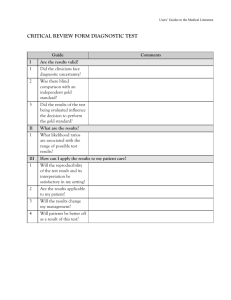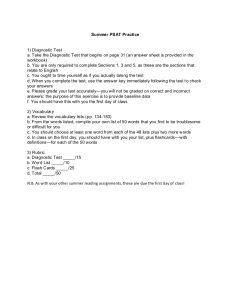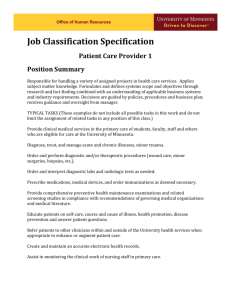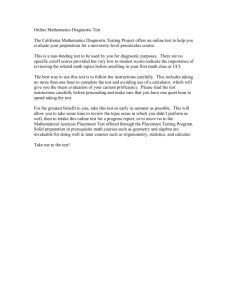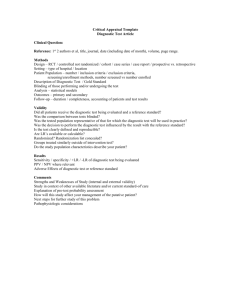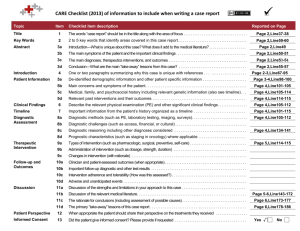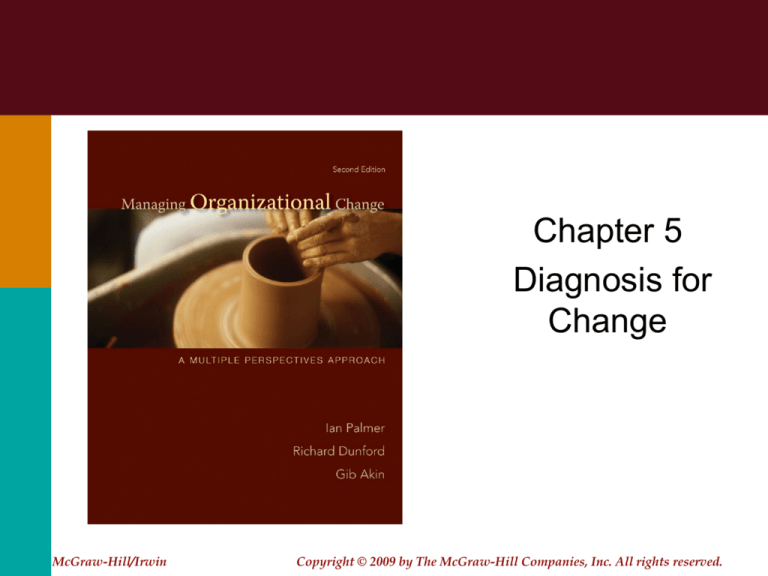
Chapter 5
Diagnosis for
Change
McGraw-Hill/Irwin
Copyright © 2009 by The McGraw-Hill Companies, Inc. All rights reserved.
Diagnostic Tools
Diagnostic
Tools
Images of
Managing
Change
Advantages
of diagnostic
tools
Diagnostic
Models:
-Organization
-Components
• The image of the change
manager has an impact on the
types of tools that may be used.
• The different images highlight the
range of reasons why tools like
these may be utilized – they
illustrate the numerous ways
change can be interpreted.
Readiness for
Change
5-2
Images of Managing Change
Diagnostic
Tools
Images
Diagnostic Tools
Director
Using diagnostic tools to build up your own knowledge base
and confidence about what needs to change by using models
that specify relationships among variables and pinpoint
where change is needed when things are not going well.
Navigator
You will find the diagnostic tools attractive; models are ways
of “mapping” the environment they describe.
Caretaker
You will be less convinced of the capacity of the diagnostic
tools to support radical change, but several of the tools (see,
e.g., PESTEL and scenario analysis) provide insights into the
trends in the external environment that you will have to take
into account.
Coach
You will focus on the diagnostic tools that highlight the goals
being sought and the competencies needed to attain them
Interpreter
You will be attracted to the diagnostic tools that emphasize
images, framing, and cognitive maps
Nurturer
Having an interest in emergent strategy, you may remain
unconvinced as to the value of such diagnostic tools.
Images of
Managing
Change
Advantages
of diagnostic
tools
Diagnostic
Models:
-Organization
-Components
Readiness for
Change
5-3
Advantages of Diagnostic Tools
Diagnostic
Tools
Images of
Managing
Change
Advantages
of diagnostic
tools
Diagnostic
Models:
-Organization
-Components
Readiness for
Change
• Simplify a complex situation.
• Identify priorities for attention.
• Highlight interconnectedness of
various organizational properties (e.g.,
strategy and structure).
• Provide a common “language” with
which to discuss organizational
characteristics.
• Provide a guide to the sequence of
actions to take in a change situation.
5-4
Diagnostic Models: Organization
Diagnostic
Tools
Images of
Managing
Change
Advantages
of diagnostic
tools
Diagnostic
Models:
-Organization
-Components
Readiness for
Change
• Six-box organizational model:
– The key focus here is on six variables – purpose,
structure, rewards, helpful mechanisms,
relationship and leadership. This model is useful
to maintain awareness of all areas for
consideration even though one variable may be
identified as the main area for attention.
• 7-S framework:
– The 7-S framework: this focuses on seven key
components that affect organizational
effectiveness – structure, systems, style, staff,
skills, strategy and superordinate goals. The
interconnectedness of these variables is vital to
the success of change.
• Star model:
– An organization is effective when the five
components of organizational design – strategy,
structure, processes and later capability, reward
systems and people practices – are in alignment.
5-5
Diagnostic Models: Organization
Diagnostic
Tools
Images of
Managing
Change
Advantages
of diagnostic
tools
Diagnostic
Models:
-Organization
-Components
Readiness for
Change
• Congruence model:
– The organization is broken down into four components
– task, individuals, formal organizational arrangements
and informal organisation. This is influenced by the
context where the strategy is formulated and the output
is then the performance of the organization.
• Burke-Litwin model:
– This model identifies the transformational – external
environment, mission and strategy, leadership and
organizational culture - and transactional sources of
change.
• Four frame model:
– This offers four frames for the managers to
conceptualize how the organization operates. These
frames are structural, human resource, political and
symbolic frames.
• Diagnosis by image:
– This technique allows organizational members to use
images to describe the organizations and this can be
used as a basis for discussion.
5-6
Diagnostic Models: Components
Diagnostic
Tools
•
Images of
Managing
Change
•
Advantages
of diagnostic
tools
Diagnostic
Models:
-Organization
-Components
Readiness for
Change
PESTEL Framework:
– This analyses the external environment in terms of six factors
– political, economic, social, technological, environmental and
legal.
Scenario analysis:
– Creating stories of possible future scenarios that are
considered to be vital to the future of the organization
•
Gap analysis
– This is a tool used for reviewing the organization’s position
based on where they are and where they want to get to.
•
Elements of strategy
– These are five elements of strategy that are considered
mutually reinforcing – arenas, vehicles, differentiators, staging
and lowest costs through scale advantage. Any misalignment
of these signifies the need for change.
•
Strategic inventory
– This aims to identify the strategic assumptions of managers
and determine their consistency with the business
environment. This determines whether the strategy should be
a focal point for change.
5-7
Diagnostic Models: Components
Diagnostic
Tools
• Newsflash exercise:
Images of
Managing
Change
• Cultural web:
Advantages
of diagnostic
tools
Diagnostic
Models:
-Organization
-Components
Readiness for
Change
– This is an exercise that encourages managers to be
very specific and succinct about change and clearer
about the intended outcomes.
– This provides a way of mapping the organizational
culture through seven elements – paradigm, rituals and
routines, stories, symbols, control systems, power
structures and organizational structure
• Structural dilemmas:
– Six possible structural dilemmas that can be
encountered during change are diagnosed so areas
that have been “traded-off” during the change process
can be identified
• The Boundaryless Organization:
– Success is arguably achieved only if four types of
organizational boundaries are diagnosed and reduced.
These are vertical, horizontal, external and
geographical boundaries.
5-8
Readiness for Change
Diagnostic
Tools
Images of
Managing
Change
Advantages
of diagnostic
tools
Diagnostic
Models:
-Organization
-Components
Readiness for
Change
• Assessing the organization's readiness to
change can be a mediating variable between
change management strategies and the
outcomes of desired strategies.
• A perchance audit of the readiness of an
organization for change can provide an
indication of the likely outcome of a change
initiative at a particular point in time. Some
ways of doing this include:
– Questionnaires
– Stakeholder analysis: This focuses on the position
of stakeholders in the change process and allows
the manager to be better informed of how to
confront potential issues.
– Force-field analysis: This identifies factors that are
driving forces for change as well as restraining
forces.
5-9

